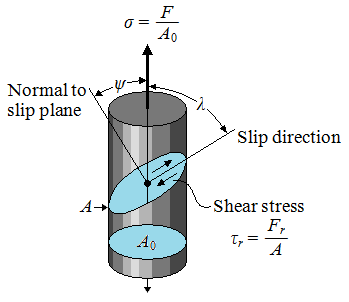

| Schmid's Law |
| Schmid's Law |
| F | unidirectional force |
| λ | angle defining slip direction relative to the force |
| ψ | angle defining the normal to the slip plane |
| Fr | shear force |
| A | area of slip plane |
| τr | resolved shear stress in the slip direction |
| σ | unidirectional stress applied to the cylinder |
 |  |
| A resolved shear stress τ is produced on a slip system | Movement of dislocations on the slip system deforms the material |
| Eq1 |
|
| τr = |
|
| σ = |
|